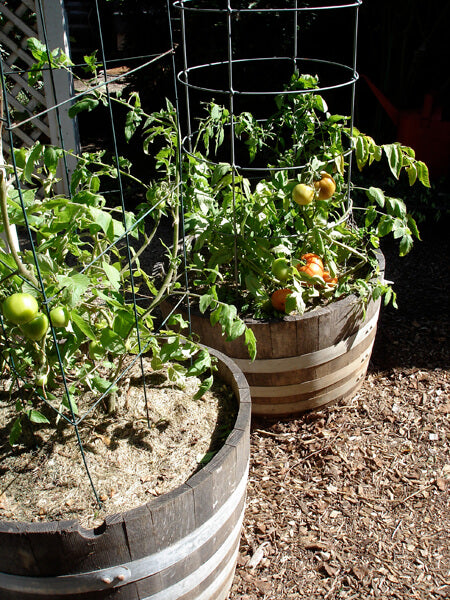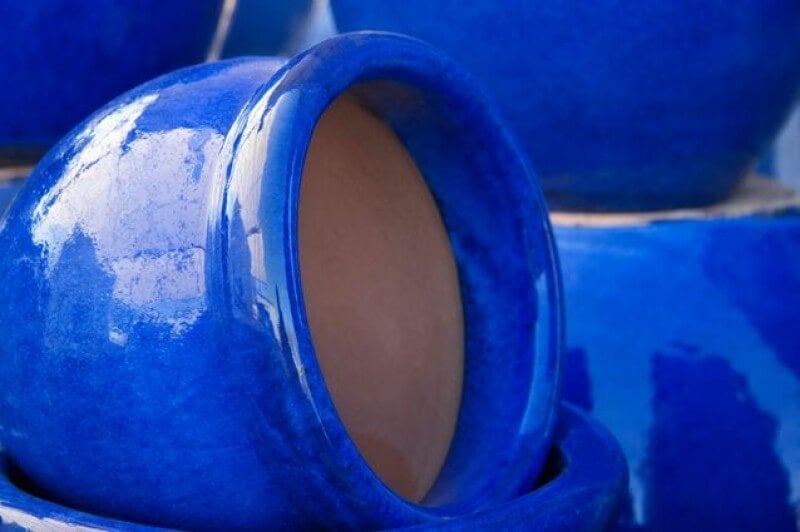Pots are made from a variety of materials, and some will suit your situation better than others. Keep in mind that you need a pot large enough to support plant growth all season and there must be a drainage hole in the bottom of the pot. Elevating the pot on pot feet or atop a trio of bricks will keep the pot off surfaces that might stain. No matter what kind of container you choose to grow in, be sure to fill it with premium quality potting mix, such as Miracle-Gro® Potting Mix, to give plants a strong start. Below are most of the typical choices.
Clay
Clay pots are readily available, good for growing plants, and attractive. However, they can be expensive and heavy in large sizes, breakable if dropped, and many are subject to cracking in freezing temperatures. Because the clay is porous, it allows for good air exchange, but your clay pot will dry out more quickly than other types. It also absorbs heat quite well—a plus in early spring, but not so great in mid-summer in hot climates. If you are going to spend more than $20 on a pot, look for terra cotta with a frost-proof guarantee. Fired and glazed pots are the most weather proof.
Plastic
Versatile in appearance, lightweight, durable, and affordable, plastic pots are good for plant growth. Without a doubt, some are more attractive than others. Some have realistic finishes that mimic terra-cotta, concrete, or stone, and some have rolled rims to give the illusion of thickness. Larger sizes can be as expensive as pots made of more traditional materials. Generally with plastic you get what you pay for. Cheaper pots may fade and crack in time, while more expensive ones made of polypropylene do not fade or crack quickly, and some also offer good insulation. One bonus of plastic is that it doesn't have to be watered quite as often as clay. Dark-colored plastic pots absorb more heat than light-colored ones. If you're not concerned about eye-appeal, consider recycling large, black nursery containers used for trees and large shrubs.
Glazed Ceramic
These are the most colorful pots, ranging from subtle earthen tones to playful, vibrant glazes. They are varied in style and good for plant growth. Most of these pots are less subject to freeze damage, so they are a good investment. Because many of these pots are currently imported from Asia, check with the retailer about their ability to withstand freezing weather. They are heavy and moderately expensive in larger sizes. They will break or chip if dropped.
Fiberglass
These classically styled, durable, and lightweight containers command premium prices. Plants grow well in them. Because they are more expensive, these pots are harder to find and you'll probably have less choice of size and style. The downside is that fiberglass can be brittle and may crack if dropped, nor is it a good insulator from heat or cold. Some are made to look like stone, wood, or other materials and can be quite ornamental in a prominent spot.
Concrete
Attractive, durable, and affordable, concrete pots can be found for sale from local, wayside shops that manufacture them, as well as in highly styled forms from the trendiest shops. They are good for plant growth. They can be expensive in large sizes, and they are certainly heavy, making them challenging to bring home or move in the garden. Because they are concrete, consider them permanent.
Foam
These pots are readily available and affordable in a variety of styles. They are good for plant growth, particularly where the insulation protects roots from heat and cold, and they are very lightweight. Due to the limited strength of the material, they are usually found in smaller sizes.
Metal
Galvanized metal buckets, brass or copper pots, and other containers made from metal can be very ornamental. Often you can make a nice container from metal tins or galvanized buckets by drilling drainage holes in the bottom. Generally, the thicker the metal, the longer these last. You can also plant in plastic liners to insert in these pots. Plastic liners also help insulate roots from the transfer of extreme heat and cold, one of the drawbacks of metal.
Self-watering
Usually made of plastic, these are containers with a reservoir at the base that holds water for later use. Often you can even water directly into the reservoir. Such designs are good time savers.
Whiskey Barrels
For their size, these oak half-barrels are the most affordable choice. They are informal in style and last for several years. Once filled with soil and planted, they are heavy. As they age, they become more fragile, making them impossible to move. The wood is a good insulator.








 Herbs
Herbs
 Vegetables
Vegetables
 Fruit
Fruit
 Flowers
Flowers
 Succulents
Succulents


